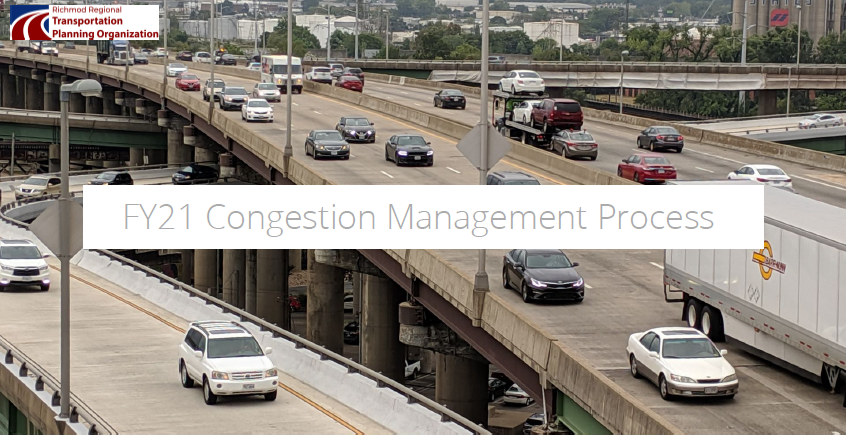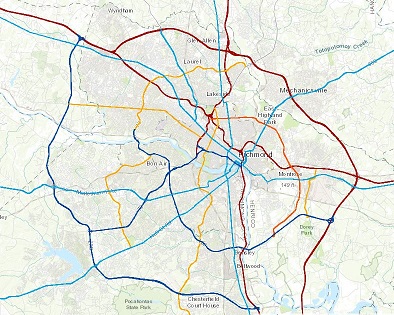Core products
Congestion Management Process
FY21 CMP Update
The Congestion Management Process (CMP) is a cyclical process which continually evolves as congestion issues, data sources, strategies, and goals and objectives change over time. The CMP tracks system performance measures, outlines strategies to manage demand, and works to ensure the continued reliability of the regional multimodal transportation system.
Federal regulations require that a CMP be in place in all Transportation Management Areas (TMAs) or urban areas over 200,000 in population. The CMP is implemented as a continuous part of the metropolitan planning process, which includes the Long Range Transportation Plan (LRTP), the Transportation Improvement Program (TIP), and the Unified Planning Work Program (UPWP).
The FY20 Congestion Management Process Update is highlighted in the story map in the right sidebar.
There are eight actions that form the major components of a CMP. The following items outline how these CMP actions are addressed in the planning process of the Richmond Regional Transportation Planning Organization.
1. Develop regional objectives
The regional objectives reflected in the CMP, are in line with the goals of the Long Range Transportation Plan (LRTP). The current LRTP goals focus on access to employment, congestion mitigation, freight mobility, multimodal connectivity, system reliability, safety and transportation/ land use integration. Elimination of all congestion is not the objective of the regional planning process.
2. Define the CMP Network
The CMP monitors the transportation system located in the Richmond Regional Transportation Planning Organization study area.
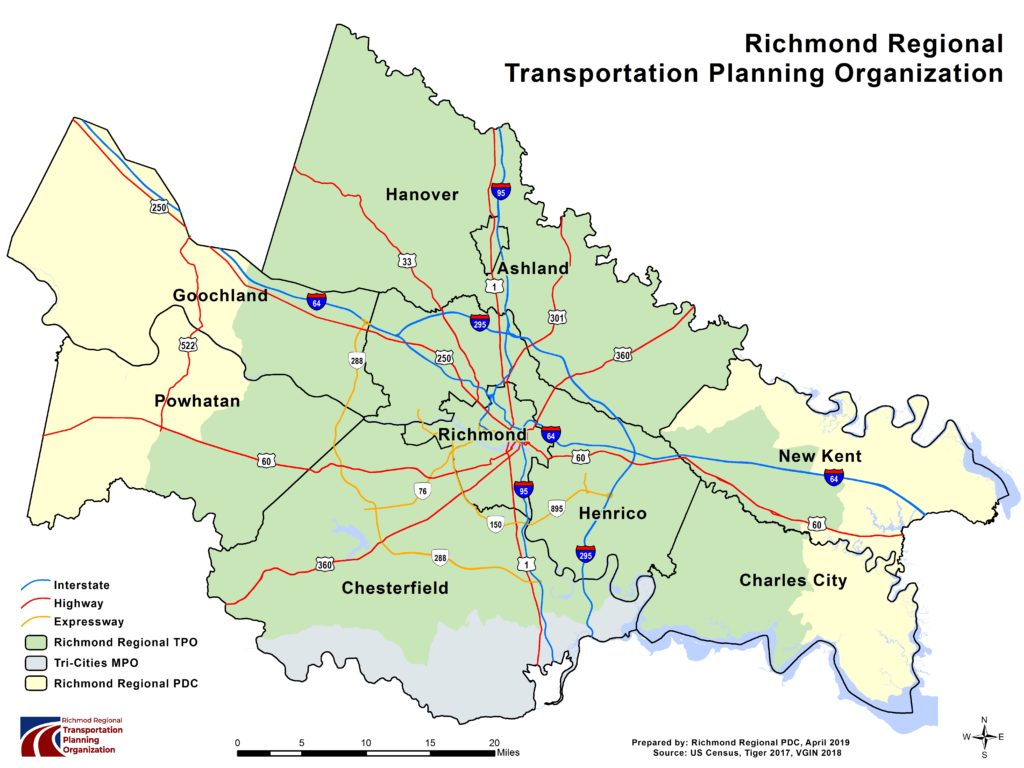
The study area is within the boundary of the Richmond Regional Planning District which is made up of the Town of Ashland, the counties of Charles City, Chesterfield, Goochland, Hanover, Henrico, New Kent and Powhatan, and the City of Richmond. Hanover and Henrico counties are fully within the study area as is the City of Richmond. A majority of Chesterfield County is also within the study area except for the southern portion which is within the Tri-Cities Area MPO. The eastern portions of Goochland and Powhatan counties and the western portions of Charles City and New Kent counties complete the study area.
The CMP roadway network is comprised of the National Highway System roadways in the Richmond Regional TPO study area and consists of interstates, other freeways and expressways, and other principal arterials.
3. Develop multimodal performance measures
The performance measures in the CMP provide data on the state of the regional CMP roadway network and allow for the analysis of congestion over time. The measures highlight where the network is experiencing problems and where conditions are improving. Several of the performance measures in the CMP are developed using INRIX real-time, historical and predictive traffic information. INRIX collects anonymous, real-time GPS data which is used by:
- Federal Highway Administration (FHWA) as the basis of the National Performance Measures Record Data Set (NPMRDS)
- Virginia Department of Transportation (VDOT) to report federal performance measures regarding roadway reliability
- Center for Advanced Transportation Technology Laboratory (CATT Lab) at the University of Maryland in their Probe Data Analytics tools
Performance measures from these sources include, Travel Time Index (TTI), Level of Travel Time Reliable (LOTTR), and Truck Travel Time Reliable (TTTR). TTI is the ratio of observed travel time to travel time at free-flow conditions and is a measure of congestion. LOTTR is the ratio of the 80th percentile travel time to the 50th percentile travel time and is a measure of reliability. Truck Travel Time Reliable (TTTR) measures reliability for freight.
4. Collect data/monitor system performance
The RRTPO partners with FHWA, VDOT, and the I-95 Corridor Coalition to access the data and tools necessary for analyzing INRIX (vehicle probe) data. The RRTPO has been monitoring system performance using the CATT Lab Probe Data Analytics since 2014.
RRTPO tracks AM and PM TTI on the regional CMP roadway network and reports on areas with recurring congestion or bottlenecks.
Locations with safety issues, which can lead to non-recurring congestion, are reported using Potential Safety Improvement (PSI) safety designation scores developed by VDOT. Data on incidents and removal times, another factor in the severity of non-recurring congestion, will be reported beginning in 2019.
Beginning in 2019 LOTTR, TTTR and Percent Person Miles Reliable, federal performance measures of reliability, will be tracked using data developed by VDOT.
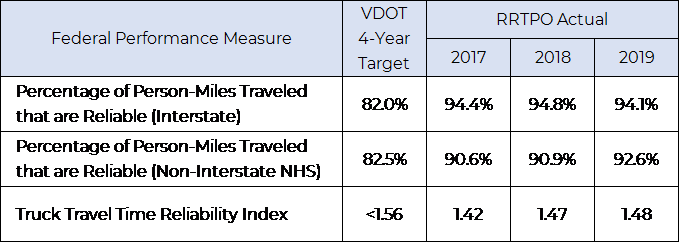
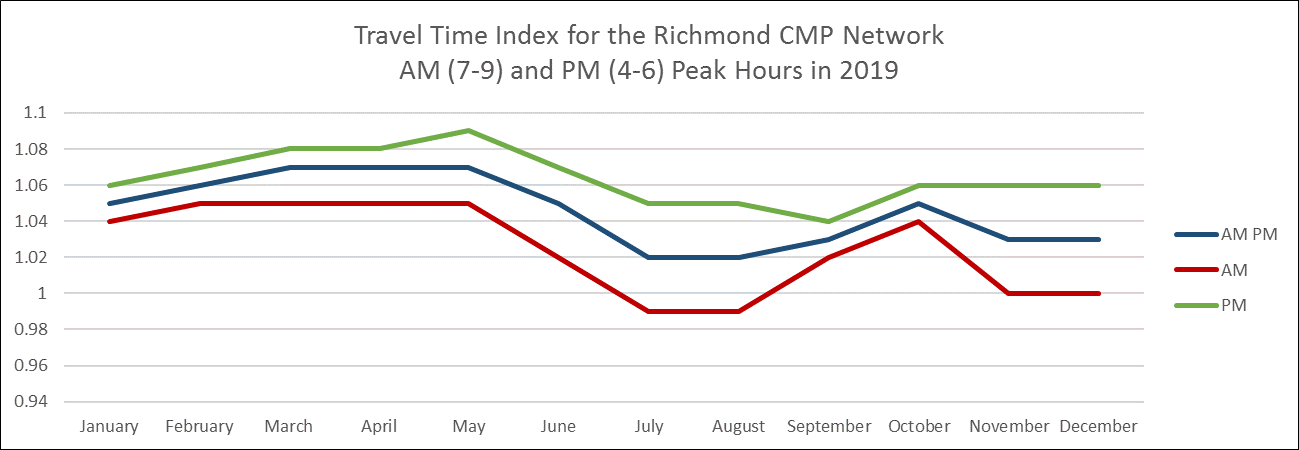
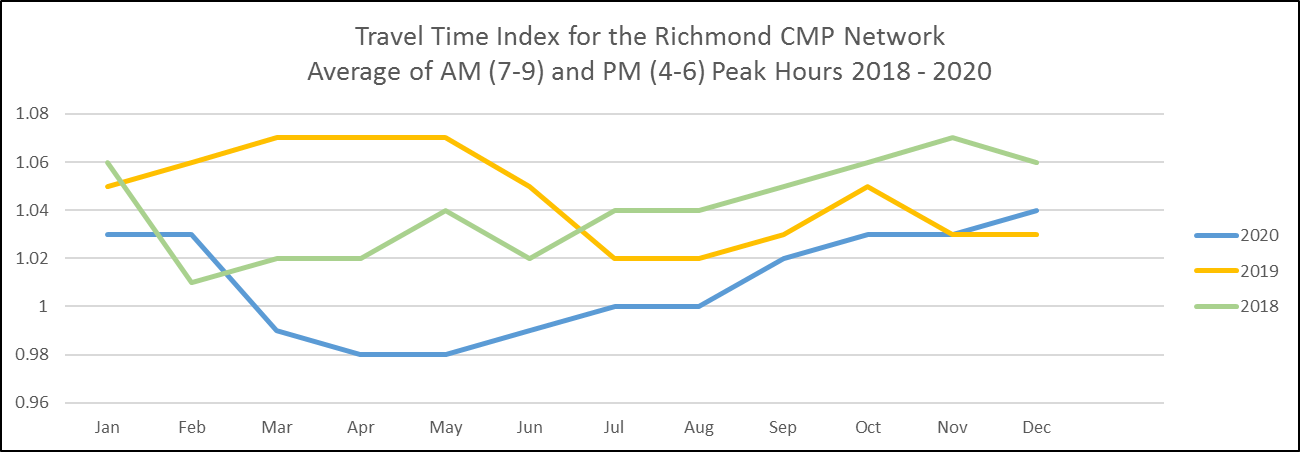
5. Analyze congestion problems and needs
Recurring and Non-recurring Congestion
There are two types of congestion, recurring and non-recurring.
Recurring congestion occurs when there are more vehicles on the roadway than the roadway capacity can handle. Recurring congestion impacts the mobility of the regional transportation system.
Non-recurring congestion occurs when an unexpected event happens and slows traffic. Non-recurring congestion impacts the reliability of the regional transportation system.
Recurring congestion is analyzed by monitoring the travel time index and through bottleneck reports. Non-recurring congestion is analyzed by monitoring the federal performance measures: level of travel time reliability, percent person-miles reliable, and truck travel time reliability. Incident clearance times and PSI scores are other factors used to analyze non-recurring congestion.
You can find the CMP update analysis in the CMP story map.
6. Identify and assess strategies
Congestion Management strategies can be grouped into four categories:
- Demand Management Strategies which focus on providing more transportation options by promoting the use of alternative modes, managing and pricing assets, altering work patterns, and influencing land use.
- Traffic Operations Strategies which focus on increasing the efficiencies of the roadway network using intelligent transportation systems (ITS).
- Public Transportation Strategies which focus on improving transit service and coverage and rely on transportation demand management (TDM) and ITS.
- Road Capacity Strategies which focus on adding a capacity to the roadway network through redesign and new construction.
The implementation of these strategies is not mutually exclusive, and they often overlap, with new construction to add capacity being the last option to be considered.
Sample RRTPO strategies for each category
7. Program and implement strategies
Congestion management strategies are included in the application scoring process for Regional Surface Transportation Block Grant (RSTBG) and (Congestion Mitigation Air Quality) CMAQ allocations. These strategies have been programmed into the Transportation Improvement Program (TIP) and are important aspects of the Long Range Transportation Plan (LRTP).
8. Evaluate strategy effectiveness
The performance measures used in the CMP are updated regularly and are used to track the performance of the system overall. Using dashboards, quarterly updates, and a story map, trends in congestion are tracked and data is available for review.


